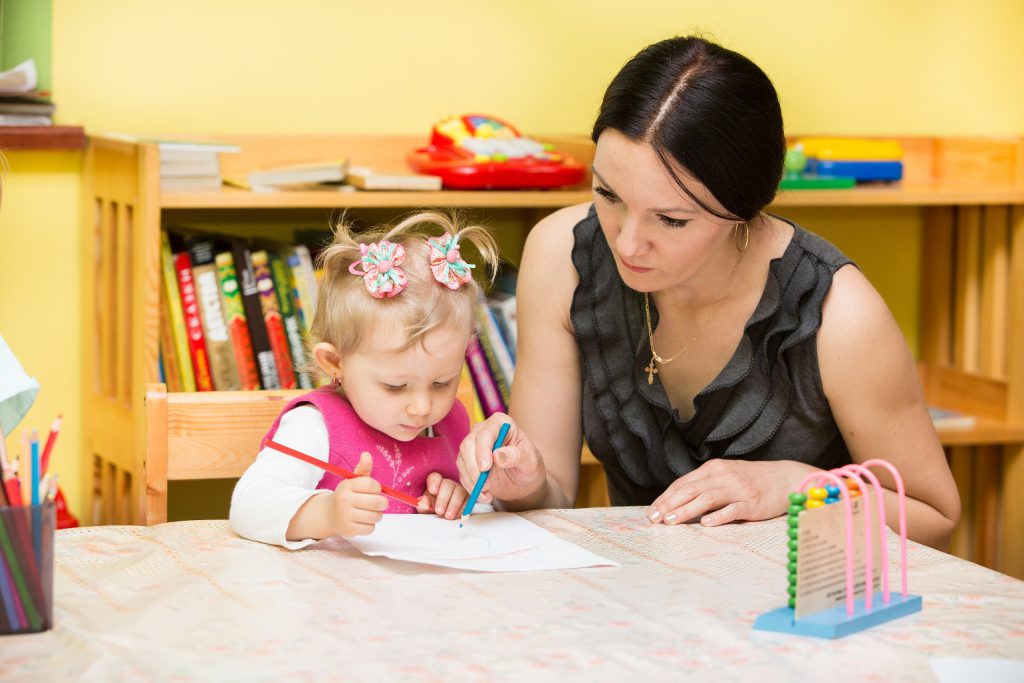What Does Common Core Mean for Early Learners?
As school curriculums and employer demands become ever more challenging, it stands to reason that children need to prepare more thoroughly for their future academic and business endeavors. This has led to the creation of the so-called Common Core State Standards (CCSS) as a way to ensure that children receive sufficient training in the core academic areas.
The Common Core is a set of high-quality academic standards focusing on mathematics and English language arts/literacy (ELA). They are designed for kindergartners - 12th graders (K-12), to support school readiness and provide students with the knowledge necessary for success in college, career and life. In short, they specify learning objectives for each grade.


 For instance, it’s age-appropriate for kindergartners to do some basic math. However, from a behavioral point of view, they can hardly be expected to do it quietly for more than 15 minutes. Instead, it should be incorporated in some sort of fun, game-like activity, which promotes creative expression and development of communication and executive-function skills.
Literacy skills can be strengthened through content-rich, engaging activities, such as dramatic play and science activities. Another point of consideration is that educators may feel pressured to strictly adhere to the standards in order to ensure measurable outcomes, rather than employ a more creative and relaxed approach to teaching.
This raises the question of whether teachers will be able to implement the standards without neglecting children’s individual needs. Will the standards eliminate creative thinking and reduce education to pure memorization of facts? Furthermore, not all children develop at the same pace during their early years. This renders the assessment of specific academic skills difficult.
For instance, it’s age-appropriate for kindergartners to do some basic math. However, from a behavioral point of view, they can hardly be expected to do it quietly for more than 15 minutes. Instead, it should be incorporated in some sort of fun, game-like activity, which promotes creative expression and development of communication and executive-function skills.
Literacy skills can be strengthened through content-rich, engaging activities, such as dramatic play and science activities. Another point of consideration is that educators may feel pressured to strictly adhere to the standards in order to ensure measurable outcomes, rather than employ a more creative and relaxed approach to teaching.
This raises the question of whether teachers will be able to implement the standards without neglecting children’s individual needs. Will the standards eliminate creative thinking and reduce education to pure memorization of facts? Furthermore, not all children develop at the same pace during their early years. This renders the assessment of specific academic skills difficult.
 Pre-K standards are not regulated in the same way as K-12. Generally, state-funded early education programs are required to abide by state guidelines. For the private daycare centers, the implementation of the guidelines is voluntary. According to experts, the alignment of pre-K and K-12 will greatly benefit educators, children and parents. Pre-K paves the way for K-12 and beyond, and shouldn’t be viewed in isolation.
The bottom line is that academic expectations for early learners must consider the children’s developmental needs. Small children preparing for school cannot be treated in the same way as their older counterparts. As children’s primary educators, parents have a vital role that can’t be covered by any standard. They need to talk to the children about the things they learn, read together, and encourage educational activities at home.
Recognizing the value of early childhood education, we at Kinder IQ offer interactive and fun educational tools, designed to shape young minds as creatively and as effectively as possible.
The KinderIQ free Kindergarten Readiness Test features dozens of online questions to help you assess your child's readiness for school and allows you to compare your responses to thousand of other parents so you know where to focus future learning activities.
Pre-K standards are not regulated in the same way as K-12. Generally, state-funded early education programs are required to abide by state guidelines. For the private daycare centers, the implementation of the guidelines is voluntary. According to experts, the alignment of pre-K and K-12 will greatly benefit educators, children and parents. Pre-K paves the way for K-12 and beyond, and shouldn’t be viewed in isolation.
The bottom line is that academic expectations for early learners must consider the children’s developmental needs. Small children preparing for school cannot be treated in the same way as their older counterparts. As children’s primary educators, parents have a vital role that can’t be covered by any standard. They need to talk to the children about the things they learn, read together, and encourage educational activities at home.
Recognizing the value of early childhood education, we at Kinder IQ offer interactive and fun educational tools, designed to shape young minds as creatively and as effectively as possible.
The KinderIQ free Kindergarten Readiness Test features dozens of online questions to help you assess your child's readiness for school and allows you to compare your responses to thousand of other parents so you know where to focus future learning activities.

Reasons for introducing the Common Core standards
The standards came about as a result of observing the years-long stagnation in the student educational progress, especially in the core areas of math and language. This trend was reflected in the high rate of remedial education in college, involving, among other things, poor writing skills - an aspect that should have been covered in grade school. Another reason was the lack of uniform national criteria specifying student proficiency levels per grade. This resulted in a joint state-led effort for the development of a standardized educational framework that would ensure student competence and competitiveness on an international level. The standards don’t contain specific teaching instructions & materials, but rather specify the skills children of a certain age should master. The adoption of the CCSS by the states is voluntary.What exactly does the Common Core involve?
The CCSS define the desired level of skill and knowledge for K-12 (kindergarten – 12th grade). To ensure quality and practical applicability, these standards were developed by prominent experts and educators from across the country. The standards place the main emphasis on the enhancement of critical-thinking, problem-solving and analytical skills. The English Language Arts portion of the CCSS aims to provide a satisfactory level of literacy for high school graduates. It focuses on reading, writing, speaking and listening, language and media, and technology. Among other things, guidelines include reading of increasingly complex literature on an array of topics, writing research projects, oral presentations, listening comprehension and vocabulary building. The math portion of the CCSS includes standards for mathematical practice and mathematical content, making the curriculum more focused and coherent. Mathematical practice involves problem solving, quantitative and abstract reasoning, mathematical models and the use of strategic tools. Mathematical content is sorted in domains (counting, algebra, geometry, equations, statistics and more).
What do these standards mean for our youngest scholars?
It goes without saying that children should be engaged in some form of education from an early age to make the home-school transition smoother. Although the main goal of the CCSS is to support college and work readiness, their implementation also affects our youngest. Due to the inherent social, psychological and emotional vulnerability of this population group, the aforementioned question merits thorough consideration. As with any educational standard, the main problem is that children are the ones that have to meet it, not the creators or educators. Failing to do so could potentially mean being unable to advance to another grade or continue education. Also, setting the standards to rigidly and technically (fact and skill approach) could affect children’s creativity, uniqueness and social-emotional development. According to the CCSS policymakers, the standards are developmentally appropriate for children of a specific grade. But even if the principles are theoretically sound, they still need to be properly implemented. Age-appropriate learning strategies are of utmost significance here. They don’t have to include pen and paper tests and worksheets, as children under the age of 6 learn best through play. For instance, it’s age-appropriate for kindergartners to do some basic math. However, from a behavioral point of view, they can hardly be expected to do it quietly for more than 15 minutes. Instead, it should be incorporated in some sort of fun, game-like activity, which promotes creative expression and development of communication and executive-function skills.
Literacy skills can be strengthened through content-rich, engaging activities, such as dramatic play and science activities. Another point of consideration is that educators may feel pressured to strictly adhere to the standards in order to ensure measurable outcomes, rather than employ a more creative and relaxed approach to teaching.
This raises the question of whether teachers will be able to implement the standards without neglecting children’s individual needs. Will the standards eliminate creative thinking and reduce education to pure memorization of facts? Furthermore, not all children develop at the same pace during their early years. This renders the assessment of specific academic skills difficult.
For instance, it’s age-appropriate for kindergartners to do some basic math. However, from a behavioral point of view, they can hardly be expected to do it quietly for more than 15 minutes. Instead, it should be incorporated in some sort of fun, game-like activity, which promotes creative expression and development of communication and executive-function skills.
Literacy skills can be strengthened through content-rich, engaging activities, such as dramatic play and science activities. Another point of consideration is that educators may feel pressured to strictly adhere to the standards in order to ensure measurable outcomes, rather than employ a more creative and relaxed approach to teaching.
This raises the question of whether teachers will be able to implement the standards without neglecting children’s individual needs. Will the standards eliminate creative thinking and reduce education to pure memorization of facts? Furthermore, not all children develop at the same pace during their early years. This renders the assessment of specific academic skills difficult.
What about guidelines for early childhood education?
There are currently no nationwide standards resembling CCSS for early childhood education (birth to prekindergarten). States are undertaking efforts to improve their pre-K programs by developing a Common-Core-based framework, to various extents, using different approaches. In some states, the early learning guidelines focus on all learning disciplines, not just literacy and math. Some states have developed CCSS-aligned preschool standards, suggesting creative age-appropriate teaching techniques (pretend play as a language development tool etc.). As with the kindergartners, one of the main challenges will be designing assessment tools for early childhood curriculums and standards. Small children have specific requirements and needs that must be taken into account. Also, the evaluation of educational outcomes in the preschool and kindergarten setting requires special training and professional development. Pre-K standards are not regulated in the same way as K-12. Generally, state-funded early education programs are required to abide by state guidelines. For the private daycare centers, the implementation of the guidelines is voluntary. According to experts, the alignment of pre-K and K-12 will greatly benefit educators, children and parents. Pre-K paves the way for K-12 and beyond, and shouldn’t be viewed in isolation.
The bottom line is that academic expectations for early learners must consider the children’s developmental needs. Small children preparing for school cannot be treated in the same way as their older counterparts. As children’s primary educators, parents have a vital role that can’t be covered by any standard. They need to talk to the children about the things they learn, read together, and encourage educational activities at home.
Recognizing the value of early childhood education, we at Kinder IQ offer interactive and fun educational tools, designed to shape young minds as creatively and as effectively as possible.
The KinderIQ free Kindergarten Readiness Test features dozens of online questions to help you assess your child's readiness for school and allows you to compare your responses to thousand of other parents so you know where to focus future learning activities.
Pre-K standards are not regulated in the same way as K-12. Generally, state-funded early education programs are required to abide by state guidelines. For the private daycare centers, the implementation of the guidelines is voluntary. According to experts, the alignment of pre-K and K-12 will greatly benefit educators, children and parents. Pre-K paves the way for K-12 and beyond, and shouldn’t be viewed in isolation.
The bottom line is that academic expectations for early learners must consider the children’s developmental needs. Small children preparing for school cannot be treated in the same way as their older counterparts. As children’s primary educators, parents have a vital role that can’t be covered by any standard. They need to talk to the children about the things they learn, read together, and encourage educational activities at home.
Recognizing the value of early childhood education, we at Kinder IQ offer interactive and fun educational tools, designed to shape young minds as creatively and as effectively as possible.
The KinderIQ free Kindergarten Readiness Test features dozens of online questions to help you assess your child's readiness for school and allows you to compare your responses to thousand of other parents so you know where to focus future learning activities.